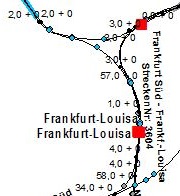Topic
transportation
2018 record(s)
Provided by
Type of resources
Available actions
Topics
Keywords
Contact for the resource
Update frequencies
-

For the calculation of the data "AIS Vessel Density", the data of the Universal Shipborne Automatic Identification System (AIS) were evaluated with regard to various parameters and ship types under stochastic aspects. The data are requested once a year for the past year from the European Maritime Safety Agency (EMSA). Among others, the information is collected and stored for the purpose of securing maritime traffic and is used for the manufacture of products produced for navigation by the Federal Maritime and Hydrographic Agency (BSH). The data "AIS Vessel Density" represent the mean spatial density distribution of the ships. The mean spatial ship density is the current number of ships that could be expected in a defined area (grid cell) at any time during a reference period under consideration. The counting distinguishes between five types of vessels: fishing vessels, cargo vessels, tankers, passenger vessels and all vessels. For more information, please visit: https://gdi.bsh.de/en/data/Vessel-Density_Dokumentation_Schiffsdichte_DE.pdf
-

For the calculation of the data "AIS Vessel Density", the data of the Universal Shipborne Automatic Identification System (AIS) were evaluated with regard to various parameters and ship types under stochastic aspects. The data are requested once a year for the past year from the European Maritime Safety Agency (EMSA). Among others, the information is collected and stored for the purpose of securing maritime traffic and is used for the manufacture of products produced for navigation by the Federal Maritime and Hydrographic Agency (BSH). The data "AIS Vessel Density" represent the mean spatial density distribution of the ships. The mean spatial ship density is the current number of ships that could be expected in a defined area (grid cell) at any time during a reference period under consideration. The counting distinguishes between five types of vessels: fishing vessels, cargo vessels, tankers, passenger vessels and all vessels. For more information, please visit: https://gdi.bsh.de/en/data/Vessel-Density_Dokumentation_Schiffsdichte_DE.pdf
-
-

Navigation Lock Filling - Modeled Geometry and Physical Model Measurement Data This data set provides the geometry files and physical model measurement data for the filling process of a large navigation lock with a ship in the lock chamber from a water saving basin. The measured data contains water levels, pressure differences, forces on the ship and the opening height of the valves. The lock consists of a lock chamber with a pressure chamber underneath. Both chambers are hydraulically connected with vertical cylindrical filling nozzles inside the floor between both chambers. The three lateral saving basins are connected to the pressure chamber via two lateral culverts each of smoothly varying rectangular shape. Each saving basin has two of these connecting culverts. A vertical lifting valve in each culvert allows the controlled filling operation from the saving basins into the pressure chamber. In the experiment, the lock chamber is filled from the lowest saving basin. The physical model was constructed at a scale of 1:25. The provided data (geometry and model test results) is scaled to prototype scale by Froude's similitude. The data was used in the following publication: Thorenz, C., Schulze, L. (2021): Numerical Investigations of Ship Forces During Lockage. Journal of Coastal and Hydraulic Strucures. Please cite the paper when using the data.
-

Transport Networks of Germany, derived from the german digital landscape model at scale 1:250000. Mapped via EuroRegionalMap to satisfy INSPIRE and European Location Framework conformance. The dataset contains the road, railway, water and air network and is available as Open Data.
-

For the calculation of the data "AIS Vessel Traffic Density", the data of the Universal Shipborne Automatic Identification System (AIS) were evaluated with regard to various parameters and ship types under stochastic aspects. The data are requested once a year for the past year from the European Maritime Safety Agency (EMSA). Among others, the information is collected and stored for the purpose of securing maritime traffic and is used for the manufacture of products produced for navigation by the Federal Maritime and Hydrographic Agency (BSH). The data "AIS Vessel Traffic Density" represent the mean spatio-temporal density distribution of the ships. This is the average number of ships that have passed through a defined area (grid cell) in a certain period of time. The counting distinguishes between five types of vessels: fishing vessels, cargo vessels, tankers, passenger vessels and all vessels. For more information, please visit: https://gdi.bsh.de/en/data/Vessel-Traffic-Density_Dokumentation_Schiffsverkehrsdichte_DE.pdf
-

-
-
HydBCsForOF is a set of hydraulic engineering boundary conditions for the Volume-of-Fluid solver "interfoam" of OpenFOAM. This is neither a part of openfoam nor endorsed by the owners of OpenFOAM. The provided boundary conditions allow the specification of water flow rates for variable water levels and the prescribtions of water levels with variable flow rates.
-

 www.geodatenkatalog.de (S3L)
www.geodatenkatalog.de (S3L)